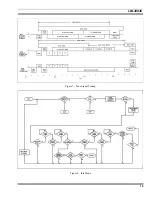
LBI-38836
17
EDACS SYSTEM DESCRIPTION
The Dual Format PCS 800 MHz digital trunked
portable radio provides fast access to available RF channels
and a degree of privacy due to selective signaling. This also
eliminates annoyance of other system user's conversations
while ensuring that intended calls are not missed.
The system uses 9600 baud high speed digital signaling
to identify individual units, user groups, fleets and agencies.
Agencies contain multiple fleets and fleets contain multiple
user groups simultaneously all the way down to individual
users can be accessed. This programming to determine
transmit encoded groups and decoded received groups is
contained in the personality EEPROM contained in the
portable. This information is individually programmed to
each users needs via the PC programmer for the radio.
Typical system configuration consists of at least 2
repeater stations (with a maximum number of 25), and the
associated portables. One repeater always is a control
channel which is dedicated to sending out continuous
control data and also to receiving channel request data from
the portables. When a portable is first turned on it scans the
available list of frequencies programmed in the personality
EEPROM for a control channel. When a control channel is
found the portable locks onto the frequency and monitors
the data for channel assignment (incoming call).
When receiving a channel assignment (incoming call),
the monitoring portable immediately switches over to the
assigned voice channel and waits for a high speed data
confirmation message. Upon receipt of this message the
voice paths are unmuted and the user can hear the call.
While on the voice channel, the portable also
continuously monitors the low speed, 150 baud (subaudible)
data and carrier noise squelch to ensure consistent operation.
Upon loss of subaudible data reception (i.e. deep fade, out
of range), the portable will return to the control channel
frequency.
To initiate a call, the user keys the radio (which is
locked to the control channel), and a 30 millisecond high
speed data slotted channel request is transmitted to the
control channel receiver. The control channel processes the
request from the portable and transmits back a voice channel
assignment on an unused channel.
When all available voice channels are in use, the control
channel will place the portable into a queue, transmit back to
the portable a queue message, and will give a channel
assignment to the requesting portable as soon as a voice
channel is free. If the system is busy and the station queue is
filled to capacity, a system busy message will be sent back
to the requesting portable and an alert will be given to the
user.
After the initiating portable receives a channel
assignment from the control station, it immediately switches
frequency over to the assigned voice channel and sends a
burst of 9600 baud dotting. The microphone voice paths are
then unmuted and the transmission begins. The transmitting
portable also continuously sends out a subaudible tone
(along with voice) for system reliability. If the station looses
this signaling, the voice channel is muted and all receiving
portables are sent back to the control channel.
In normal operation, the transmitting portable also
sends a phase shift on this subaudible tone to indicate that
the user has unkeyed, and to switch listening portables back
to the control channel.
GE-MARC SYSTEM DESCRIPTION
The GE MARC™ V
•
E digital trunked radio system
also provides fast access to available RF channels and a
degree of privacy due to selective signaling. It also
eliminates annoyance of other system user's conversations
while ensuring that intended calls are not missed.
Each system has a repeater for each channel (with a 20
channel maximum) and participating portables. The
Area/Group switch can address up to 10 systems, 10
combinations of systems and Groups within systems, or even
10 Groups within a single system. An Individual Call would
have a dedicated programmed Group encode address.
The system uses tone signaling, with each portable
being assigned 2 and/or 4 tone sequences to identify
individual units or user groups that can be accessed. Groups
of portables are assigned the same tones, so that any unit can
talk to all other units in the same group. Programming to
determine transmit encoded groups and received decoded
groups is contained in the non-volatile Personality
EEPROM within the radio, as individually programmed for
each user's needs with the PC programmer.
In a GE-MARC V trunked system with a Dual Format
PCS System radio, a radio can be programmed to be able to
make a Special Call (a telephone interconnect) as an
alternative to a programmed dispatch group call for each
Area address. Thus for each Area address with its list of
channel frequencies, two tone sets can be encoded for
transmission, a Group tone set and a Special Call tone set.
For the Direct Mode “Talk- Around” feature a
command from the radio's logic circuitry will cause the
Voltage Controlled Oscillator (VCO) to switch from the






































